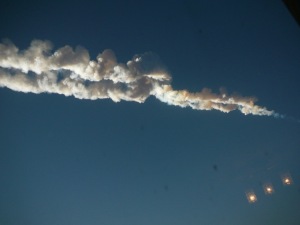A little less than a year ago, on 15 February, 2013, a meteor approximately 20 meters in diameter exploded in an airburst about 60 kilometers from the Russian city of Chelyabinsk. An article in last week’s issue of Science provides an overview of the incident and a summary of its effects. Even though the energy of the explosion was some 25 times as powerful as the atomic bomb dropped on the Japanese city of Hiroshima near the end of World War II, fortunately, the damage on the ground was minimal, mostly confined to broken windows and other superficial damage to buildings caused by the shockwave. There were nearly 1,200 injuries ̵ most were minor burns or eye injuries from the fireball produced as the meteor burned up in the atmosphere, and a smaller number of people received cuts and abrasions from flying glass or debris. It could have been much, much worse ̵ the Chelyabinsk area has a population of over 3 million people.
How much worse? A survey of the damage from a similar event that occurred in 1908, at Tunguska, in Russia, is a good barometer. A meteor approximately twice the size of the one that exploded over Chelyabinsk produced an explosion some 185 times as powerful as the Hiroshima bomb. Trees were felled by the explosion over an area of greater than 800 square miles and a man reported being burned by the fireball some 40 miles from the epicenter of the blast. Again, fortunately, Tunguska is a remote area, so injuries were low and damage to buildings was confined to a few villages. Only two deaths were reported as a result of the explosion. Had this event occurred over an area as populous as Chelyabinsk, the consequences are too terrible to contemplate.
While thousands of extraterrestrial objects enter Earth’s atmosphere each year, most simply burn up, causing no discernable effects on the surface. Even some that result in significant explosions go unnoticed, because they occur in very remote areas. A few make it all the way to Earth’s surface – for instance, it is estimated that some 4 – 6 tons of material from the Chelyabinsk strike did so, but not all in a single chunk. The size of a meteorite that hits the Earth is inversely proportional to the probability that it will strike at all, so significant impacts are mercifully rare. However, rare does not mean nonexistent.
In 1998, The NASA Near-Earth Object (NEO) Program Office was established to monitor potentially hazardous near-Earth objects. In 2005, the U.S. Congress finally provided specific funding for this activity, with the goal of cataloging 90% of potentially hazardous NEOs by 2020. Previously undiscovered NEOs (some of significant size) are discovered continually, however none with a significant probability of a present-day impact have been found so far. The largest object with a significant probability of hitting the Earth discovered to date is 99942 Apophis, a 330-meter wide asteroid. In 2004, a probability of 2.7% that it would collide with Earth in 2029 was assigned, but this was subsequently reduced to near zero after new information was gathered.
What actions would be taken if a NEO of destructive size, with a high probability of impact, was discovered? While this is a favorite theme for science fiction writers and Hollywood, actual alternatives are few. The option we are most capable of carrying out is to simply crash a spacecraft into the object, hoping to change its course sufficiently to avert a collision with Earth. If the object is too big for that, the next best approach is nuclear explosion(s) on the surface or below the surface, either to divert it of break it up into pieces that will have a less catastrophic effect if they strike. This seems to be the most effective approach with today’s technology. Installation of a device that would provide a “slow push” of constant acceleration in a safe direction has also been proposed, but this is the most expensive and the least feasible approach using current technology.
Long warning periods (decades, at least) are generally required for the success of any scheme. NASA warns that 30-80 percent of potentially hazardous NEOs are too far away for launch systems that we currently have, or those that we plan to have in the foreseeable future, to reach.
Technology is a double-edged sword. Many see the invention of nuclear weapons as the beginning of the end for humanity. However, should a potentially lethal NEO target our planet, they could be our salvation. As current treaties prohibit the deployment of nuclear weapons in outer space, international cooperation is an absolute requirement for this option. One can only hope that it would be easily secured.

